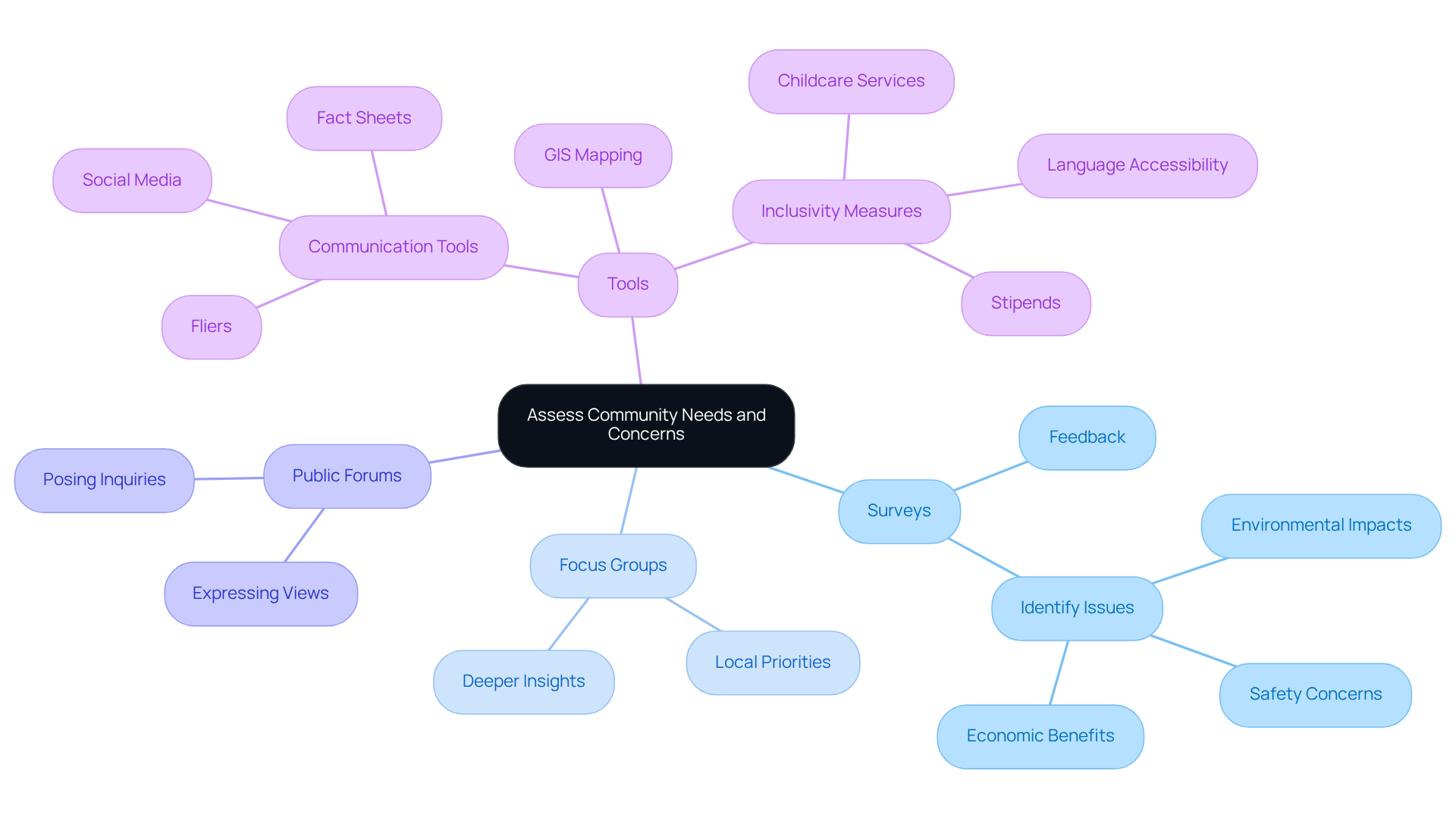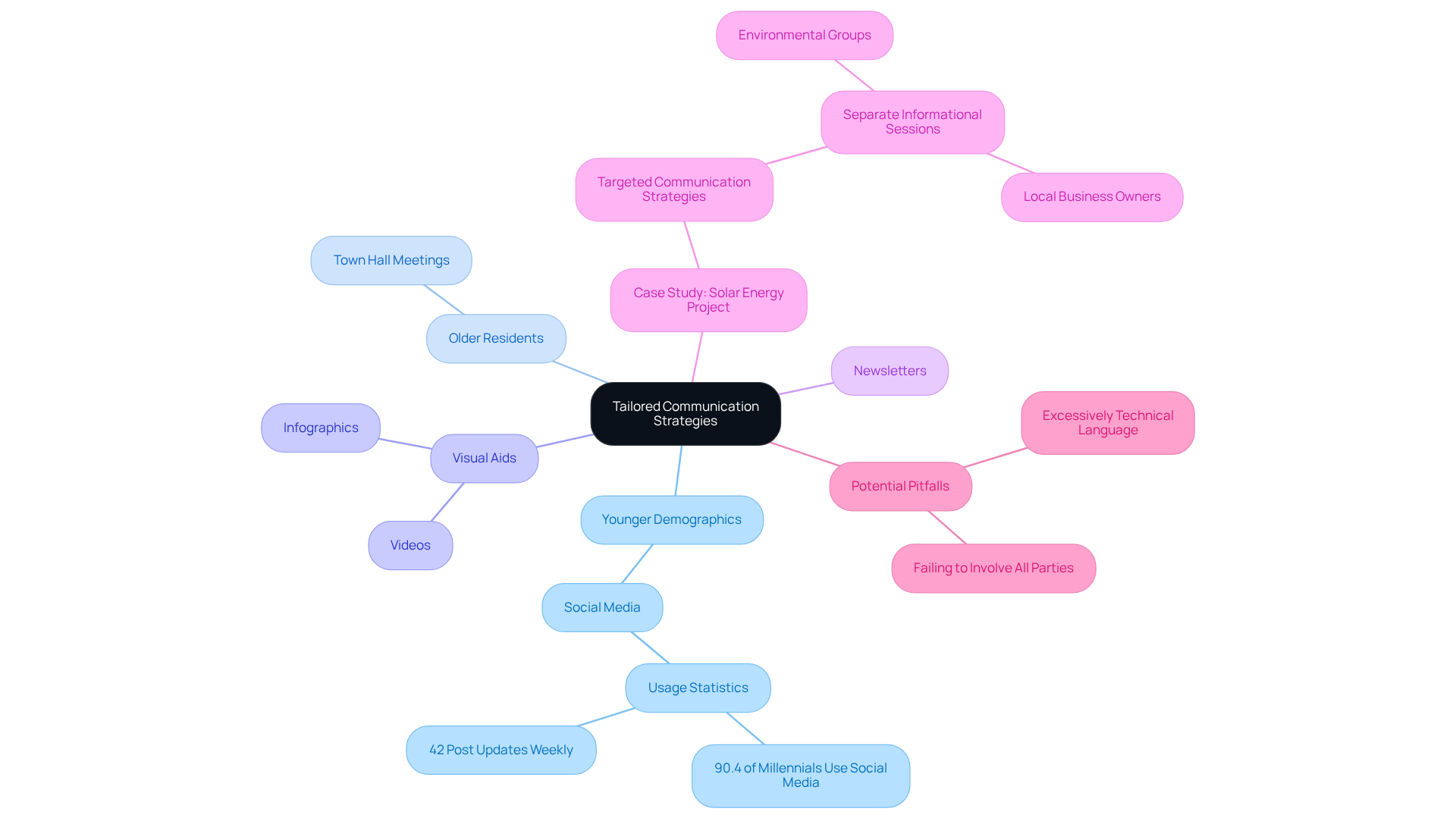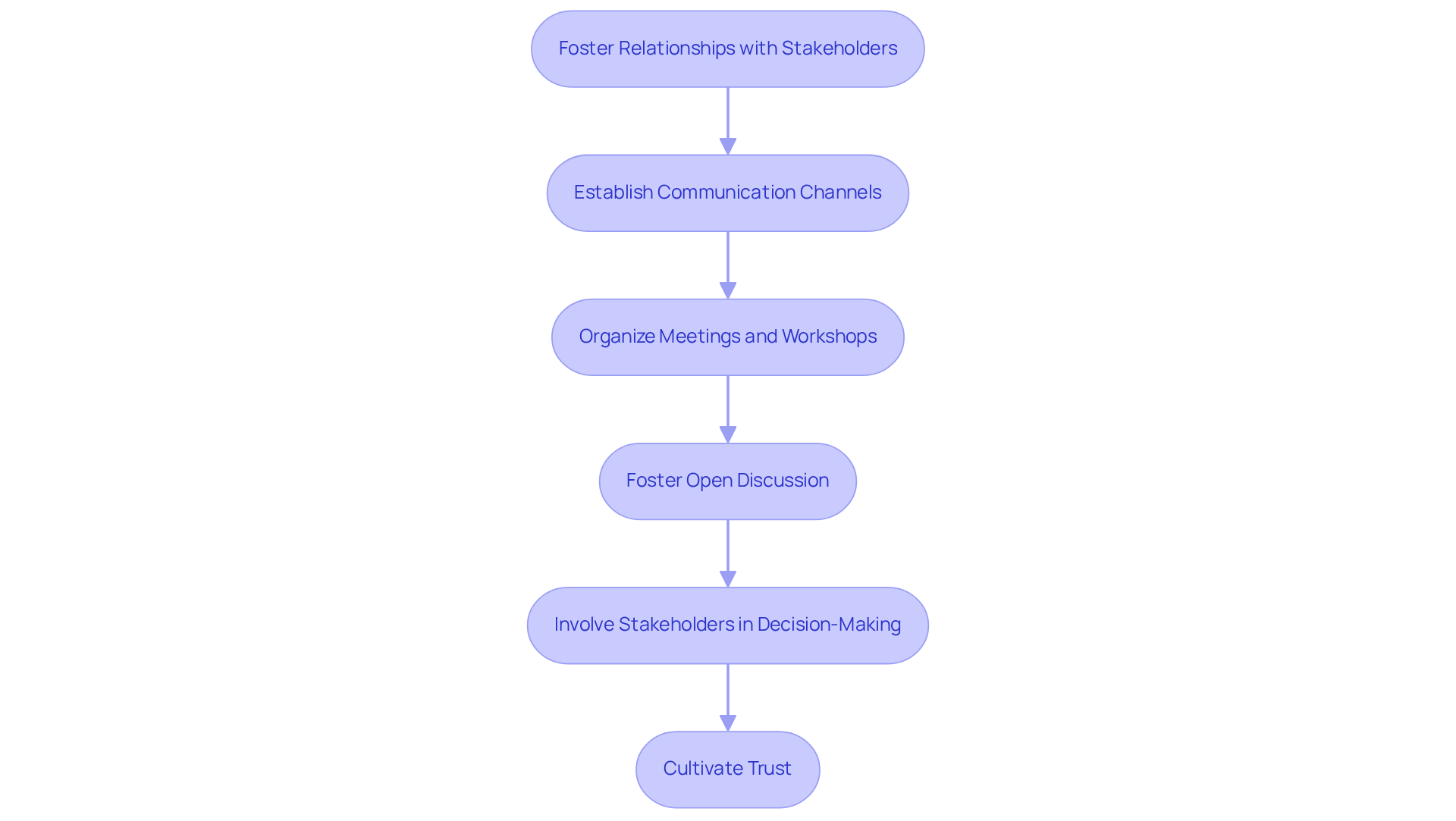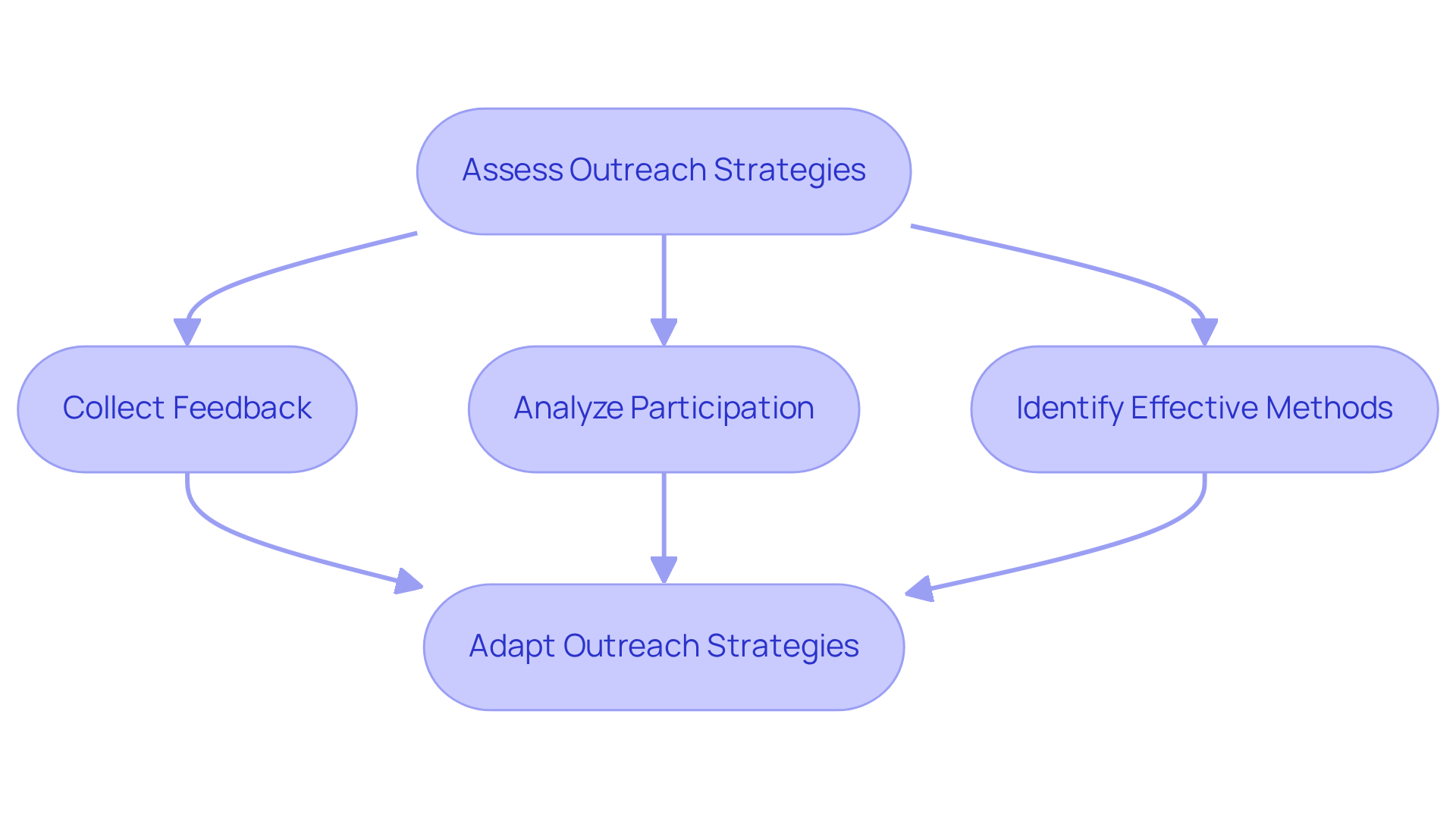Overview
The article delves into four essential strategies for effective community outreach in gas pipeline projects. It underscores the critical need to:
- Assess community needs
- Develop tailored communication strategies
- Foster relationships with stakeholders
- Evaluate outreach efforts
Each strategy is supported by various methods:
- Surveys and public forums are employed to gather community feedback
- Targeted communication engages diverse demographics
- Proactive stakeholder involvement builds trust
- Continuous evaluation allows for the adaptation of outreach tactics
Collectively, these approaches aim to enhance community support and ensure project success.
Introduction
Navigating the complexities of gas pipeline projects requires more than just technical expertise; it demands a robust strategy for community outreach. As energy infrastructure initiatives increasingly intersect with local communities, understanding and addressing their needs and concerns is vital. This article explores four key strategies that not only enhance community engagement but also foster trust and collaboration among stakeholders.
How can project teams effectively bridge the gap between technical objectives and community interests, ensuring alignment for successful project execution?
Assess Community Needs and Concerns
To effectively assess community needs and concerns, project teams must engage in comprehensive outreach activities, including:
- Surveys: Gather direct feedback from community members to identify specific issues related to gas pipeline projects, such as environmental impacts, safety concerns, and economic benefits.
- Focus Groups: Facilitate discussions that allow for deeper insights into local priorities and concerns.
- Public Forums: Offer a platform for local members to express their views and pose inquiries.
Employing tools such as GIS mapping, which Harbinger Land uses in its site and right-of-way acquisitions, can illustrate local demographics and land use patterns, offering valuable context for grasping regional priorities. By actively listening to local residents and allowing them to express themselves during public meetings, organizations can build trust and show their dedication to addressing regional concerns. This approach is essential for fostering a positive relationship with the populace.
A prominent instance is a gas pipeline initiative in the Midwest that relied on community outreach for gas pipeline projects, effectively conducting surveys among locals and uncovering substantial worries regarding possible environmental effects. By tackling these issues early in the planning phase and emphasizing the economic advantages, such as job creation, the project team adjusted their strategy, leading to increased local support and smoother project execution. Furthermore, utilizing various communication tools such as fliers, fact sheets, and social media can enhance outreach efforts, ensuring that all communication is culturally appropriate, inclusive, and accessible. Reducing barriers to participation, such as offering stipends or childcare services, further emphasizes the commitment to inclusivity in civic engagement efforts.

Develop Tailored Communication Strategies
Creating customized communication approaches is crucial for effectively engaging different segments of the population in community outreach for gas pipeline projects. By recognizing unique groups within the population, we can craft messages that resonate with their specific concerns and interests. For instance, leveraging social media platforms effectively reaches younger demographics; indeed, 90.4% of millennials actively use at least one social network, with 42% posting updates at least once a week. Conversely, organizing town hall meetings caters to older residents who may prefer face-to-face interactions. Additionally, employing visual aids, such as infographics and videos, clarifies intricate information regarding community outreach for gas pipeline projects, making it more understandable to the public. Frequent updates via newsletters or local bulletins are essential components of community outreach for gas pipeline projects, keeping stakeholders informed and engaged throughout the initiative lifecycle.
A notable example is a solar energy project that implemented targeted communication strategies by hosting separate informational sessions for environmental groups and local business owners. This method not only catered to the particular interests of each group but also greatly enhanced neighborhood relations and garnered support from both factions. As highlighted by industry specialists, maintaining clarity in communications is essential for ensuring that information is comprehended by various segments of the population. However, it is crucial to recognize potential pitfalls in communication strategies, such as failing to involve all pertinent parties or using excessively technical language that may exclude certain groups. Such customized strategies not only boost engagement but also promote trust and cooperation among various segments of society.

Foster Relationships with Stakeholders
Nurturing connections with interested parties is paramount for the success of energy infrastructure initiatives, particularly in terms of community outreach for gas pipeline projects. Project teams must proactively engage in community outreach for gas pipeline projects by establishing regular communication channels with key stakeholders, such as local government officials, community leaders, and advocacy groups. Community outreach for gas pipeline projects involves organizing meetings and workshops with these parties, fostering open discussion that allows them to express concerns and participate in planning. Involving stakeholders in decision-making processes enhances their sense of ownership and support for the initiative. Trust is cultivated through transparency and accountability, which are essential for sustaining these relationships.
Harbinger Land's expertise in site and right-of-way acquisitions, bolstered by advanced GIS modeling services, plays a vital role in this engagement process. By leveraging integrated GIS mapping and title research services, teams can efficiently negotiate and secure the necessary leases and easements for development. This approach not only conserves time and resources but also facilitates informed decision-making that aligns with the interests of all involved parties.
A notable example of community outreach for gas pipeline projects is a Texas initiative that formed an advisory committee made up of local residents, business owners, and environmental advocates. This committee convened regularly to discuss developments and address concerns, resulting in a collaborative approach that significantly reduced resistance. Such initiatives underscore the effectiveness of stakeholder advisory committees in fostering positive relationships and ensuring smoother execution.

Evaluate and Adapt Outreach Efforts
Assessing and adjusting community outreach for gas pipeline projects is crucial for enhancing participation in these initiatives. This process necessitates a consistent evaluation of the effectiveness of communication strategies and local involvement activities through various methods, such as feedback surveys, monitoring social media sentiment, and analyzing attendance at public events. For instance, the Railroad Commission of Texas successfully engaged over 8,000 attendees at events in the first quarter of Fiscal Year 2025, clearly demonstrating the impact of community involvement efforts. Identifying effective methods and areas needing enhancement allows teams to make informed modifications to their outreach strategies. Reallocating resources to more effective communication channels can significantly elevate participation levels.
A notable example of this approach can be seen in a renewable energy initiative in California, which established a feedback loop that enabled local residents to provide input on outreach efforts. This initiative uncovered that online webinars resonated more with specific demographics than traditional in-person meetings. As a result, the team adapted their strategy, leading to improved overall public involvement.
Furthermore, sustaining responsive feedback loops through community outreach for gas pipeline projects not only demonstrates a commitment to collaboration but also strengthens connections with local stakeholders. This iterative process fosters trust and encourages ongoing dialogue, which is essential for the success of energy projects. It is imperative to incorporate ESG principles into outreach strategies, as they enhance the impact of initiatives and align them with global standards for sustainable practices. Additionally, addressing common pitfalls in community engagement—such as failing to adapt to community dynamics or neglecting transparent communication—is vital for ensuring effective outreach.

Conclusion
Engaging effectively with communities surrounding gas pipeline projects is essential for fostering trust and ensuring project success. Prioritizing community needs and actively involving residents in the decision-making process allows project teams to create a more inclusive environment that addresses concerns while highlighting the benefits of such initiatives. This approach not only mitigates resistance but also enhances overall project acceptance and support.
The article outlines four key strategies for successful community outreach:
- Assessing community needs through surveys and discussions
- Developing tailored communication strategies for diverse demographics
- Fostering relationships with stakeholders to build trust
- Evaluating outreach efforts to adapt and improve engagement
Each of these strategies plays a critical role in creating a collaborative atmosphere that values local input and adapts to community dynamics.
Ultimately, the significance of robust community outreach cannot be overstated. It is imperative for gas pipeline projects to not only communicate effectively with stakeholders but also to actively listen and respond to their concerns. By doing so, project teams can pave the way for smoother implementations and lasting community relationships, ensuring that energy infrastructure projects align with the values and needs of the communities they serve.
Frequently Asked Questions
What are the main methods for assessing community needs and concerns regarding gas pipeline projects?
The main methods include conducting surveys to gather direct feedback, facilitating focus groups for deeper discussions, and hosting public forums for community members to express their views.
How can GIS mapping be beneficial in community outreach for gas pipeline projects?
GIS mapping can illustrate local demographics and land use patterns, providing valuable context for understanding regional priorities and concerns.
Why is it important to engage with local residents during public meetings?
Engaging with local residents builds trust and demonstrates the organization's dedication to addressing regional concerns, which is essential for fostering a positive relationship with the community.
Can you provide an example of effective community outreach in a gas pipeline project?
A gas pipeline initiative in the Midwest effectively conducted surveys among locals, uncovering substantial worries about environmental impacts. By addressing these concerns early and highlighting economic benefits like job creation, the project team adjusted their strategy, leading to increased local support.
What communication tools can enhance outreach efforts for gas pipeline projects?
Various communication tools such as fliers, fact sheets, and social media can enhance outreach efforts, ensuring that communication is culturally appropriate, inclusive, and accessible.
How can organizations promote inclusivity in civic engagement efforts?
Organizations can promote inclusivity by reducing barriers to participation, such as offering stipends or childcare services, which emphasizes their commitment to engaging all community members.
List of Sources
- Assess Community Needs and Concerns
- Community engagement, outreach, and public participation best practices | Colorado Department of Public Health and Environment (https://cdphe.colorado.gov/community-engagement-outreach-and-public-participation-best-practices)
- National Pipeline Performance Measures (https://phmsa.dot.gov/data-and-statistics/pipeline/national-pipeline-performance-measures)
- Economic Impact of Natural Gas Pipeline Projects on Local Communities - Woodway Energy (https://woodwayenergy.com/economic-impact-of-natural-gas-pipeline-projects-on-local-communities)
- Natural Gas Gathering and Transmission Pipelines and Social Vulnerability in the United States - PMC (https://pmc.ncbi.nlm.nih.gov/articles/PMC8214100)
- Quotable Fracking Quotes (https://conservationcouncil.ca/quotable-fracking-quotes)
- Develop Tailored Communication Strategies
- 45+ Important Communication Skills Statistics & Trends For 2024 (https://passivesecrets.com/communication-skills-statistics)
- US Northeast Transco expansion, Constitution Pipeline revivals in the works, Williams says (https://spglobal.com/commodity-insights/en/news-research/latest-news/natural-gas/052925-us-northeast-transco-expansion-constitution-pipeline-revivals-in-the-works-williams-says)
- What is the best way to create a project communication plan for project closure in Project Management? (https://linkedin.com/advice/1/what-best-way-create-project-communication-plan)
- How to communicate with external stakeholders: manage complex projects (https://airswift.com/blog/external-stakeholder-communication)
- Social Media Fact Sheet (https://pewresearch.org/internet/fact-sheet/social-media)
- Foster Relationships with Stakeholders
- (PDF) Stakeholder engagement and influence: Strategies for successful energy projects (https://researchgate.net/publication/382514218_Stakeholder_engagement_and_influence_Strategies_for_successful_energy_projects)
- TOP 25 STAKEHOLDER QUOTES (of 56) | A-Z Quotes (https://azquotes.com/quotes/topics/stakeholder.html)
- Clarity trumps assumptions in stakeholder engagement (https://articulous.com.au/clarity-trumps-assumptions-in-stakeholder-engagement)
- Stakeholder Management Quotes (https://stakeholdermap.com/stakeholder-management-quotes.html)
- Evaluate and Adapt Outreach Efforts
- What is Community Engagement in ESG? (https://esgvoices.com/post/what-is-esg-community-engagement)
- Pipelines Emphasize Early, Dedicated Outreach Against Growing Protests to Construction (https://naturalgasintel.com/news/pipelines-emphasize-early-dedicated-outreach-against-growing-protests-to-construction)
- 121624 RRC Criss-Crosses Texas for Extensive Outreach in New Fiscal Year (https://rrc.texas.gov/news/121624-rrc-criss-crosses-texas-for-extensive-outreach-in-new-fiscal-year)
- Boosting Community Engagement in Energy Projects: Strategies - sustainableliving.org.nz (https://sustainableliving.org.nz/boosting-community-engagement-in-energy-projects-strategies)
- Using Community Feedback to Improve Community Interventions: Results from the Deep South Network for Cancer Control Project - PMC (https://pmc.ncbi.nlm.nih.gov/articles/PMC4991235)




